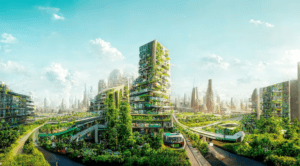As the world grapples with the urgent need to address climate change, the concept of net zero buildings has gained significant traction. In Saudi Arabia, where sustainability and environmental responsibility are becoming paramount, the retrofitting of existing buildings and the integration of new technologies play a vital role in achieving net zero emissions. This article explores the importance of net zero buildings, focusing on retrofits and innovative technologies that are driving sustainable transformation in Saudi Arabia.
Understanding Net Zero Buildings
Net zero buildings are structures that achieve a balance between energy consumption and renewable energy generation, resulting in zero net carbon emissions. These buildings strive to minimize energy usage through efficiency measures and offset any remaining emissions by producing renewable energy on-site or sourcing it from off-site renewable sources. They contribute significantly to mitigating climate change by reducing greenhouse gas emissions. They also help conserve natural resources, improve indoor air quality, and promote sustainable development in line with the country’s environmental goals.
Retrofitting Existing Buildings for Net Zero Performance
- Energy Efficiency Upgrades: Retrofitting existing buildings involves implementing energy-efficient measures such as insulation, efficient lighting, advanced HVAC systems, and smart controls. By improving the energy performance of older structures, Saudi Arabia can significantly reduce their carbon footprint and enhance their overall sustainability.
- Renewable Energy Integration: To achieve net zero status, existing buildings can incorporate renewable energy technologies such as solar panels, wind turbines, and geothermal systems. These installations allow buildings in Saudi Arabia to generate clean energy on-site, reducing reliance on conventional energy sources and contributing to a greener future.
Innovative Technologies for Net Zero New Buildings
Integrating advanced automation systems and controls enables buildings in Saudi Arabia to optimize energy consumption. Smart technologies, such as occupancy sensors, intelligent lighting systems, and automated HVAC controls, enhance energy efficiency, reduce waste, and improve occupant comfort. Incorporating energy storage systems, such as batteries and thermal storage, facilitates the efficient utilization of renewable energy generated on-site. These technologies allow buildings in Saudi Arabia to store excess energy for use during peak demand periods or when renewable sources are not readily available, ensuring a continuous supply of clean energy.
Financial Incentives and Policy Support
Saudi Arabia has implemented various programs and policies to promote energy efficiency and renewable energy adoption. Initiatives such as the Saudi Green Initiative and the National Renewable Energy Program provide incentives, grants, and regulatory support for the implementation of net zero building projects, encouraging sustainable practices in the construction and retrofit sectors. The private sector in Saudi Arabia is increasingly recognizing the value of net zero buildings. Collaboration between developers, investors, and construction companies is driving innovation and creating opportunities for sustainable real estate projects. Financial institutions are also offering incentives and funding options for these initiatives, further accelerating their adoption.
Overcoming Challenges and Ensuring Long-term Success
Raising awareness and educating stakeholders, including building owners, developers, architects, and policymakers, is essential for successful net zero building implementation. Training programs, workshops, and awareness campaigns can promote the understanding of sustainable practices and foster a culture of environmental responsibility. To ensure the long-term success of net zero buildings in Saudi Arabia, life cycle assessment and ongoing monitoring are crucial. Assessing the environmental impact of materials, monitoring energy performance, and conducting regular audits contribute to continuous improvement and optimization of building operations.
Holistic Design Principles
- Passive Design Strategies: An integrated design approach focuses on incorporating passive design strategies that optimize natural lighting, ventilation, and thermal insulation. By utilizing building orientation, shading devices, and efficient building envelope design, net zero buildings in Saudi Arabia can reduce energy consumption and enhance occupant comfort.
- Whole Building System Integration: Integrating various building systems, such as HVAC, lighting, and renewable energy generation, ensures their seamless operation and maximum energy efficiency. This approach allows for synergies between different systems and optimizes the overall performance of net zero buildings.
Collaboration among Disciplines
- Architects and Engineers: Effective collaboration between architects and engineers during the design phase is crucial for achieving net zero building goals. Architects must consider energy-efficient building forms, while engineers provide technical expertise in implementing energy systems and optimizing building performance.
- Building Information Modeling (BIM): The use of BIM technology facilitates collaboration among stakeholders, including architects, engineers, contractors, and facility managers. BIM allows for the visualization, simulation, and analysis of building performance, enabling informed design decisions and enhancing the overall energy efficiency of net zero buildings in Saudi Arabia.
Intelligent Energy Management Systems
- Real-time Monitoring and Control: Implementing intelligent energy management systems enables real-time monitoring and control of building operations. These systems integrate data from sensors, meters, and automation systems to optimize energy consumption, detect anomalies, and make informed adjustments for enhanced energy efficiency.
- Predictive Analytics and Machine Learning: Utilizing predictive analytics and machine learning algorithms, net zero buildings can optimize energy usage based on historical data, weather patterns, and occupancy patterns. These technologies allow for dynamic energy management, reducing waste and improving overall operational efficiency.
Material Selection and Life Cycle Assessment
- Sustainable Material Choices: The selection of environmentally friendly and low-carbon materials is crucial for net zero buildings. By prioritizing materials with high recycled content, low embodied carbon, and renewable sourcing, buildings in Saudi Arabia can minimize their environmental impact and contribute to a circular economy.
- Life Cycle Assessment (LCA): Performing life cycle assessments helps evaluate the environmental impact of building materials and systems throughout their entire life cycle. By considering factors such as manufacturing, transportation, installation, use, and end-of-life, net zero buildings can minimize their carbon footprint and make informed decisions regarding material selection and waste management.
Knowledge Sharing and Industry Collaboration
Investing in research and development initiatives focused on net zero buildings encourages innovation and the development of new technologies, materials, and design approaches. Collaborative efforts between academic institutions, government bodies, and industry professionals can drive advancements in sustainable construction practices in Saudi Arabia. Developing industry standards and certification programs specific to net zero buildings provides a framework for ensuring quality, performance, and compliance. These standards help establish benchmarks and guidelines for designing, constructing, and operating net zero buildings, fostering consistency and credibility in the industry.
Conclusion:
Net zero buildings are at the forefront of sustainable transformation in Saudi Arabia. Through retrofitting existing buildings and incorporating new technologies, Saudi Arabia can make significant strides toward achieving its environmental goals. By retrofitting existing buildings with energy-efficient measures and integrating renewable energy technologies, the country can reduce carbon emissions and conserve resources. Additionally, the integration of innovative technologies like building automation systems and energy storage solutions in new constructions enables the efficient use of energy and enhances sustainability. Government initiatives and private sector collaboration play a pivotal role in driving the adoption of these initiative buildings. Financial incentives, grants, and supportive policies encourage developers and investors to prioritize sustainability in their projects. Collaboration among stakeholders fosters innovation and creates a conducive environment for sustainable real estate development in Saudi Arabia.
However, certain challenges must be overcome for the successful implementation of net zero-building practices. Stakeholder awareness and education are essential to ensure widespread understanding and adoption of sustainable practices. Additionally, conducting life cycle assessments and implementing ongoing monitoring measures are crucial to maintaining the long-term success of net zero buildings, ensuring they continue to operate at optimal energy efficiency levels. As Saudi Arabia strives towards a greener future, the adoption of net zero building practices will contribute significantly to reducing carbon emissions, conserving resources, and promoting sustainable development. By embracing retrofits and new technologies, the country can lead the way in sustainable construction practices and inspire other nations to prioritize environmental responsibility in the built environment. Ultimately, the transformation towards net zero buildings in Saudi Arabia will play a vital role in achieving a sustainable and resilient future for generations to come.






